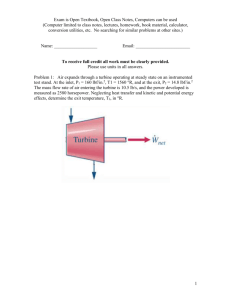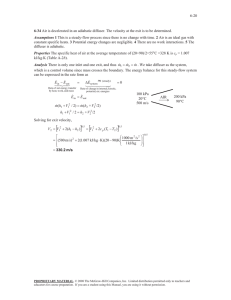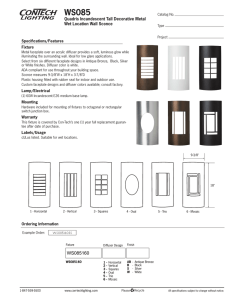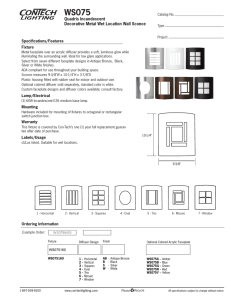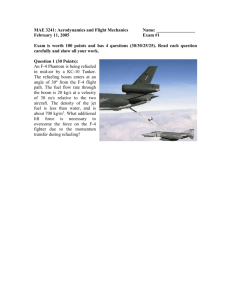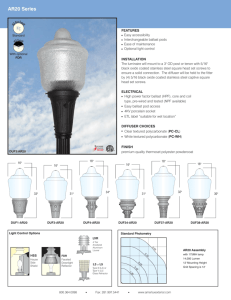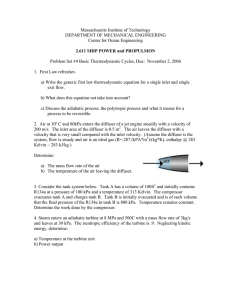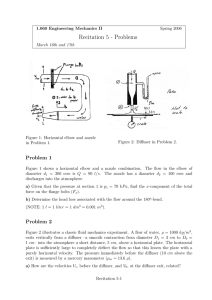CFD Based Design Optimizations of the Diffuser of a
advertisement
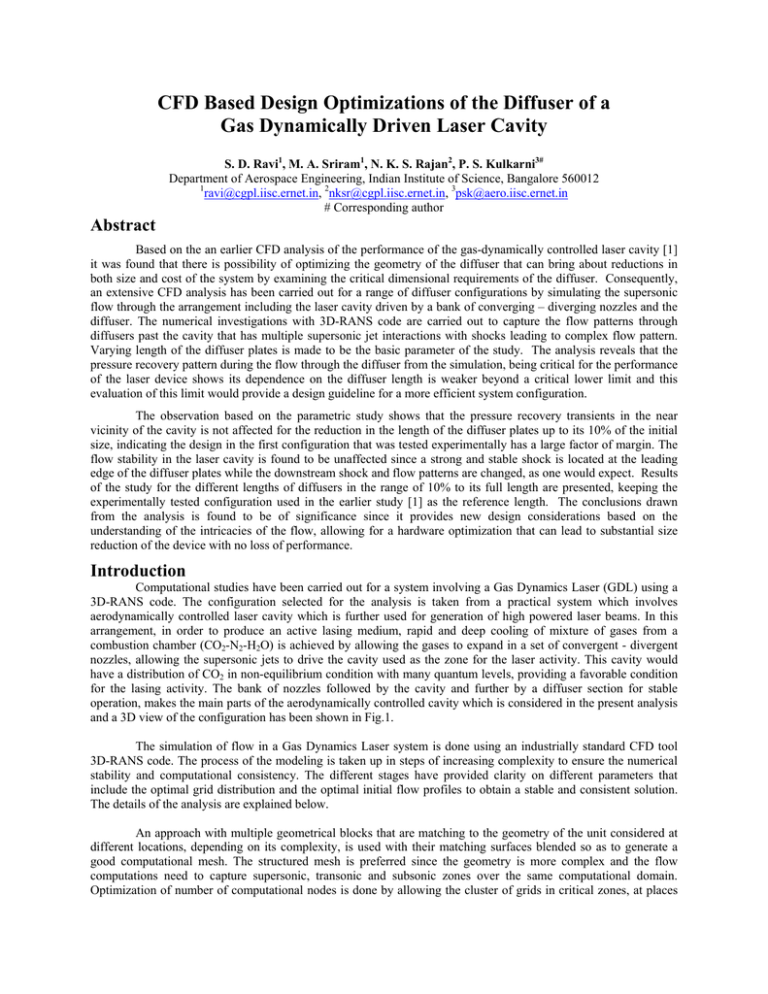
CFD Based Design Optimizations of the Diffuser of a Gas Dynamically Driven Laser Cavity S. D. Ravi1, M. A. Sriram1, N. K. S. Rajan2, P. S. Kulkarni3# Department of Aerospace Engineering, Indian Institute of Science, Bangalore 560012 1 ravi@cgpl.iisc.ernet.in, 2nksr@cgpl.iisc.ernet.in, 3psk@aero.iisc.ernet.in # Corresponding author Abstract Based on the an earlier CFD analysis of the performance of the gas-dynamically controlled laser cavity [1] it was found that there is possibility of optimizing the geometry of the diffuser that can bring about reductions in both size and cost of the system by examining the critical dimensional requirements of the diffuser. Consequently, an extensive CFD analysis has been carried out for a range of diffuser configurations by simulating the supersonic flow through the arrangement including the laser cavity driven by a bank of converging – diverging nozzles and the diffuser. The numerical investigations with 3D-RANS code are carried out to capture the flow patterns through diffusers past the cavity that has multiple supersonic jet interactions with shocks leading to complex flow pattern. Varying length of the diffuser plates is made to be the basic parameter of the study. The analysis reveals that the pressure recovery pattern during the flow through the diffuser from the simulation, being critical for the performance of the laser device shows its dependence on the diffuser length is weaker beyond a critical lower limit and this evaluation of this limit would provide a design guideline for a more efficient system configuration. The observation based on the parametric study shows that the pressure recovery transients in the near vicinity of the cavity is not affected for the reduction in the length of the diffuser plates up to its 10% of the initial size, indicating the design in the first configuration that was tested experimentally has a large factor of margin. The flow stability in the laser cavity is found to be unaffected since a strong and stable shock is located at the leading edge of the diffuser plates while the downstream shock and flow patterns are changed, as one would expect. Results of the study for the different lengths of diffusers in the range of 10% to its full length are presented, keeping the experimentally tested configuration used in the earlier study [1] as the reference length. The conclusions drawn from the analysis is found to be of significance since it provides new design considerations based on the understanding of the intricacies of the flow, allowing for a hardware optimization that can lead to substantial size reduction of the device with no loss of performance. Introduction Computational studies have been carried out for a system involving a Gas Dynamics Laser (GDL) using a 3D-RANS code. The configuration selected for the analysis is taken from a practical system which involves aerodynamically controlled laser cavity which is further used for generation of high powered laser beams. In this arrangement, in order to produce an active lasing medium, rapid and deep cooling of mixture of gases from a combustion chamber (CO2-N2-H2O) is achieved by allowing the gases to expand in a set of convergent - divergent nozzles, allowing the supersonic jets to drive the cavity used as the zone for the laser activity. This cavity would have a distribution of CO2 in non-equilibrium condition with many quantum levels, providing a favorable condition for the lasing activity. The bank of nozzles followed by the cavity and further by a diffuser section for stable operation, makes the main parts of the aerodynamically controlled cavity which is considered in the present analysis and a 3D view of the configuration has been shown in Fig.1. The simulation of flow in a Gas Dynamics Laser system is done using an industrially standard CFD tool 3D-RANS code. The process of the modeling is taken up in steps of increasing complexity to ensure the numerical stability and computational consistency. The different stages have provided clarity on different parameters that include the optimal grid distribution and the optimal initial flow profiles to obtain a stable and consistent solution. The details of the analysis are explained below. An approach with multiple geometrical blocks that are matching to the geometry of the unit considered at different locations, depending on its complexity, is used with their matching surfaces blended so as to generate a good computational mesh. The structured mesh is preferred since the geometry is more complex and the flow computations need to capture supersonic, transonic and subsonic zones over the same computational domain. Optimization of number of computational nodes is done by allowing the cluster of grids in critical zones, at places expected to have larger gradients in the flow parameters and in places where the geometry is more complex. It is observed that nearly 2 million computational nodes are required for the entire configuration. The critical section of the computational domain that includes the nozzles cavity and diffuser needs about 1.5 million nodes to get the solution. On a four node parallel computer with Pentium IV processor and 2GB of memory, a test case for the flow analysis of full configuration needs about 24 to 30 hours of CPU time. The computational flow Analysis made during the preliminary stage of the study includes flow analysis through a single nozzle followed by flow analysis through a set of four nozzles and thereafter analysis of flow through of a set of nozzles along with a set of 2 diffuser vanes. In its final stage the computations were taken up to capture the flow through multiple nozzles and the diffusers. The method of analysis, the results obtained at different stages been presented and discussed in the following sections of the paper. The Configuration and the Approach The basic configuration of the system considered for the analysis, scheme of computation, code validation with experimental data and other basic aspects of the study have been brought out in detail in an earlier work [1], and this work is an extension of this reported work. However, for clarity, the arrangement of the system configuration is shown in Fig. 1. In the present analysis, all the other hardware elements except the diffuser plates are kept unchanged, in order to have a focused parametric study. Further for simplicity of analysis, the downstream element of the diffuser – the acoustic control device is taken off from computation domain. Fig 1. A general view of the initial configuration considered A 3D-RANS code having upwinding implicit scheme and k–ω approach for turbulence is used for the numerical solution. The Reynolds-Averaged Navier-Stokes Equations are solved for steady, compressible viscous flow. The governing equations used are the conventional standard sets that include: Continuity equation: ∂U j =0 ∂x j Momentum equation: ∂ ( ρUi )+ ∂x∂ ρUiU j =− ∂∂xP − ∂x∂ τ ij + ρ ui′′u′′j ∂t j i j Energy equation: ∂ ∂ ∂ ρh + ρU j h =− Q j + ρ u ′′j h′′ ∂t ∂x j ∂x j ( ( ) ( ) ) ( ( ) ) The boundary conditions and initial conditions used include (a) no slip, impermeable and adiabatic walls; (b) inlet pressure and temperature of the fluid entering the system to be an assigned boundary value (typical outlet of a rocket combustion chamber with storable liquid propellants) and (c) the outlet from the diffuser set to match the ambient conditions. Diminishing residual criteria of the variables is used for the convergence with a limit of RMS residuals falling below 10-4. Results and Discussion Fig. 2, Mach Contours (full length) Fig. 4, Temperature Contours (full length) Fig. 6, Mach Contours (80% plate length) Fig. 3, Pressure Contours (full length) Fig. 5, Streamline Plot (full length) Fig. 7, Pressure Contours (80% plate length) Results from the study given in the Figs. 2 to 5 belong to a set of a case where the diffuser has the full length, as specified to have used in the experimental tests built based on empirical designs. The different plots show the Fig. 8, Mach Contours (30% plate length) Fig. 9, Pressure Contours (30% plate length) distribution of important aerodynamic parameters – Mach, Pressure, Temperature and velocity (as streamline plot) of the system, keeping in view of the diffuser performance, in particular. It can be observed that the reflected shocks within the diffuser plates are adequately strong enough that the pressure recovery occurs dominantly beyond the trailing edge of the diffuser plates, ensuring a ‘safe’ operating pressure range in the aerodynamic lasing cavity. The results shown in Figs. 6 to 9 show the behavior of the aerodynamic characteristics with few selective sets of diffusers with reduced plate lengths of 80% and 30%. One can observe that only the downstream flow structure is affected as compared to the initial configuration and flow in the laser cavity is not affected. This and above data sets are run for the inlet conditions (28 atm.) of the reference design set. It could be clearly made out that the length of the diffuser plates is over-designed. Alternately one can infer that the device could handle much larger variation of pressure at the inlet. To make a sensitivity analysis of the diffuser performance based on its dependence on the inlet pressure, a set of analysis was made taking the case of a 10% plate length which is most critical among other cases. A variation in the inlet pressure of about 7.5% was chosen for this study. It was found that the higher side of the pressure did not change the flow pattern categorically, while the lower pressure provided a significantly unstable flow structure with the solution fairly oscillating. In the Figs. 10 and 11 one can see the established and stable flow structure that belongs to the standard pressure. In the Figs. 12 and 13 that belong to a case with reduced inlet pressure, one can see that the flow structure is not fully formed and is unstable. It was found in this case that a steady state solution could not be reached numerically. This behavior is also visibly shown up quite clearly in the two plots shown in Figs. 14 and 15 that shows the history RMS residuals of the flow parameters with an observation that in the case of the reduced pressure the solution has been quite oscillating and is instable. It was found that further reduction in the inlet pressure did not proceed numerically, leading to an inference that with the transients of the flow instability being strong enough not allow for a steady state solution, further leading to infer that the existence of the operating limit of the inlet pressure in the device. The analysis makes it clear that it establishes that there is a working range for the device associated with the length of the diffuser plate. A consolidated plot of pressure recovery over the diffuser Fig. 10, Mach Contours (10% len, std inlet pr) Fig. 11, Pressure Contours (10% len, std inlet pr) Fig. 16. Consolidated plot of Pressure Recovery over the diffuser plates of different length plates is provided in Fig. 16 that shows that for a specified working pressure, it is possible to arrive at an optimally lower length of diffuser plate than what was used in the empirical designs based on the observation that the pressure recovery transients in the near– downstream of the cavity is not disturbed by reducing the plate length up to about 10% of its original length. This leads to a consideration that the design of the device can have a reduction in the length of the diffuser and its associated hardware significantly, that Fig. 12, Mach Contours (with 7.5% lower pr) Fig. 13, Pressure Contours (with 7.5% lower pr) Fig. 14, RMS Residual History (std pr) Fig. 15, RMS Residual History (lower pr) could lead to a major advantage in the usability and cost of the device. The outcome of the analysis also signifies the extent of CFD analysis that has given an insight of the flow behavior to provide good design guidelines. Reference: 1. Computational Analysis of Flow through a Multiple Nozzle Driven Laser Cavity and Diffuser – M A Sriram, N K S Rajan & P S Kulkarni, ICCFD–2006
